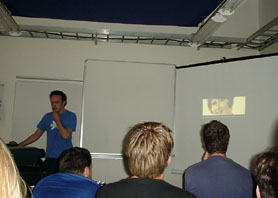PROJECT 40
HAPPENINGText: Matt Owens
A Presentation by Peter Cho from Imaginary Forces, a former student of John Maeda at MIT, showed his explorations with students at MIT,along with his typographic exploration with sound and movement. As arecent member of the Imaginary Forces team, Peter is working to bridge the gap between his expertise in the interactive realm with the visually rich broadcast capabilities of Imaginary Forces. The next year will be telling as IF begin to reinvent themselves as both a broadcast and interactive agency.

Former Antirom member Tom Roope, now at Tomato Interactive, gave his “Jack of all trades master of none” presentation on his evolution from working on CD ROMS to his current work with Tomato and clients such as Levis. For both Cho and Roope, the empirical interactive experiment, where simple forms and lines deliver both the “aesthetic” and “interactive” voice of a design solution, served as the underlying theme of several of the projects. Using Director as the tool of choice for most of his work, Roope showed how the ability to merge the power of Director’s Lingo scripting language with sound and movement can create a simple yet interactively sophisticated experience.
Benoit Platre from Ici la lune presented a series of projects showing how sound and 3D characterization can be used to bring personality and narrativity to a project. Benoit’s 3D rave characters were a humorous take on interactive story telling. Overall, the presentations of Platre, Roope, Cho and Kram showed a particular focus on the functionality of interactive design. Using C++ or Lingo requires a certain level of expertise that the traditional “web designer” does not often possess. As a result, participants and speakers alike were encouraged to think more deeply about the logistics of an interactive undertaking.
Dialogue and discussion on day two began to focus more clearly on the task at hand. Some teams still struggled to do research and to understand the current issues concerning the spread of HIV and what is being done currently by organizations, corporations and governments. Currently 70% of all HIV cases are in Africa while the majority of support and financing comes from western countries and is focused on western populations. Sweden, in particular, has only 5000 HIV/AIDS related cases and the majority of them were contracted during the eighties or are a result of immigration. Some feared that the conference could be seen as yet another symbol of a western culture “charity case,” using HIV and AIDS as the most predictable scapegoat to legitimize the project and to serve as the proverbial western culture “pat on the back.” “It is a bitter pill to swallow, but we are here, we have to see it through” commented one participant.
A fortunate result of the conference was the ability to see individuals from different companies and different capacities working together. From company owners, to designers, to information architects, everyone was placed on a common ground and was able to collaborate in a very free and open way. The coordinators of Project 40 did not participate directly in the project brainstorms or creative process. In addition, Project 40 coordinators were in constant proximity, taking pictures and asking questions to be posted on the project website. This observer/observed power dynamic was an interesting one to experience, and added to the awkwardness that sometimes underscored aspects of the conference. At one point, the edit site became the place were the “official” view of Project 40 could be seen online while postings on K10K.net expressed some of the participants genuine frustrations.
Long nights of discussions and questions of just “what to do” went into the early morning hours, cut short by a prompt 8:30AM wake up call to attend the next feedback session.
Read more ...





